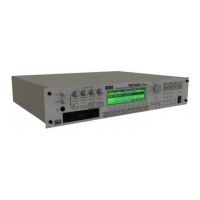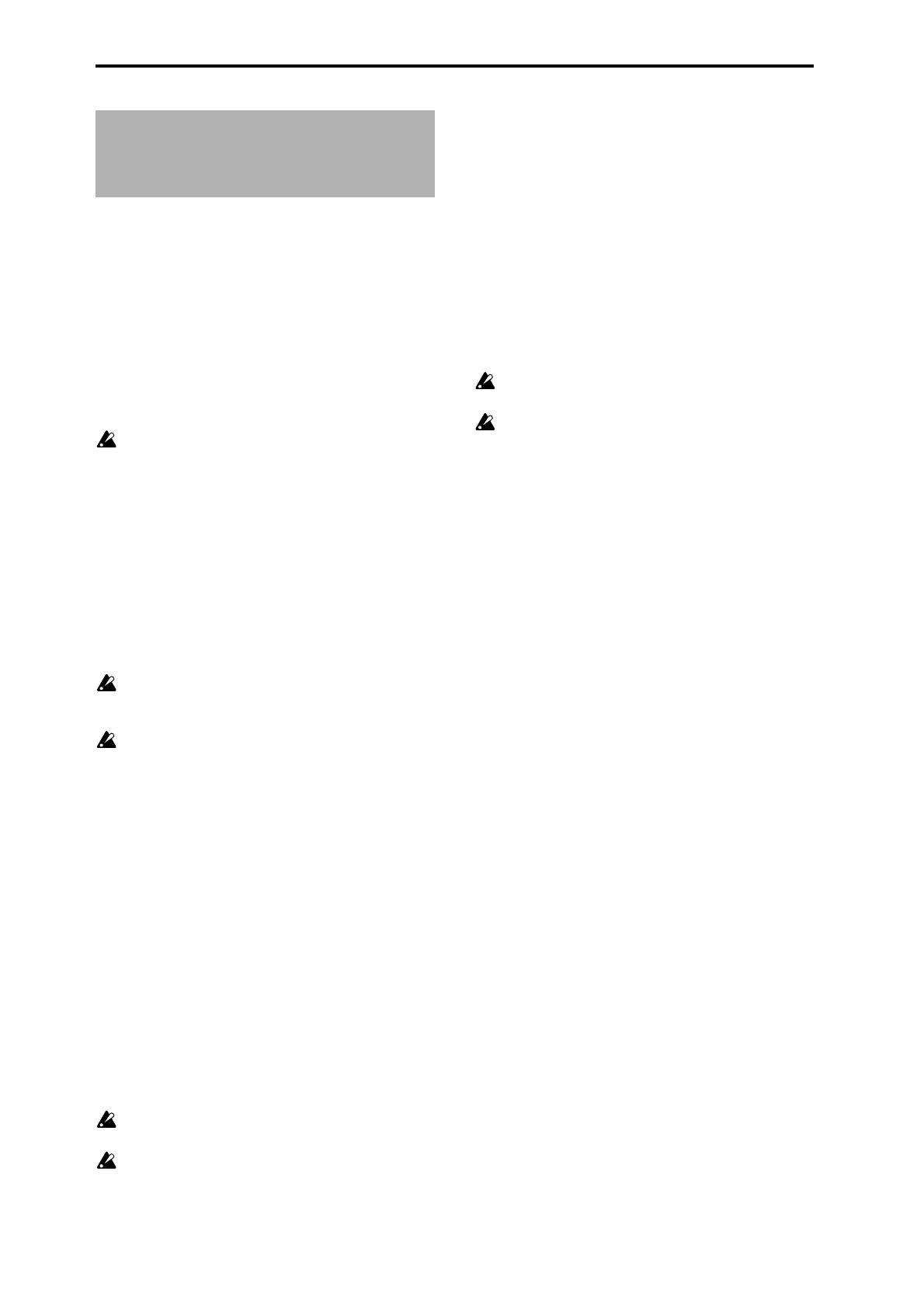216
The following table shows the relation between the MIDI
messages that are transmitted when the TRITON-Rack’s
controllers are operated, and the AMS (alternate modulation
source) or DMS (dynamic modulation source) that corre-
spond to each MIDI message. # indicates a fixed function,
and * indicates an assignable function.
When you operate the controllers of the TRITON-Rack, the
corresponding or specified control change will be transmit-
ted. Operation in each mode is described below.
Program mode
When one of the TRITON-Rack’s controllers is operated, a
control change message will be transmitted on the global
MIDI channel (“MIDI Channel” GLOBAL 2.1–1a).
If a REALTIME CONTROLS B-mode knob [1]–[4] is set
to Master Volume, the universal exclusive message
Master Volume will be transmitted.
Combination mode
When one of the TRITON-Rack’s controllers is operated, a
control change message will be transmitted on the global
MIDI channel (“MIDI Channel” GLOBAL 2.1–1a).
Simultaneously, the message will also be transmitted on the
MIDI channel (“MIDI Channel” COMBI 3.1-1a) of any tim-
bre whose “Status”(COMBI 3.1–1a) is EXT or EX2.
When one of the TRITON’s controllers is operated, its effect
will apply to any timbre whose “Status” is INT and whose
“MIDI Channel” setting is either Gch or the same as the glo-
bal MIDI channel.
In the case of Master Volume, the universal exclusive
message Master Volume will be transmitted only on the
global MIDI channel.
You can make settings for MIDI Filter (COMBI 4.1–4.4)
to enable or disable control changes and controllers for
each timbre. When checked, the above operations will
be enabled.
Effect dynamic modulation can be controlled when the
“Control Ch (Channel)” (COMBI 7.2–1b, 7.3–1a, 7.3–1d) set-
ting for IFX1–5, MFX1, 2, or MEQ is either set to Gch or to
the same channel as the global MIDI channel. (In the case of
All Routed, control is possible on the MIDI channel of any
routed timbre.)
Multi mode
When one of the TRITON’s controllers is operated, its effect
will apply to the track 1–16 that is selected by “Control
Track” (MULTI 1.1–1a, 5.1–1a, 5.1–2a).
If the “Status” (MULTI 3.1–1a/2a) of the track selected by
“Control Track” is EXT, EX2, or BTH, a control change mes-
sage will be transmitted on the MIDI channel specified by
“MIDI Channel” (MULTI 3.1–1a/2a).
If the “Status” is INT or BTH, operating one of the TRI-
TON’s controllers will affect only that track. Simultaneously,
the same effect will also apply to any track with the same
“MIDI Channel” setting.
In the case of Master Volume, the universal exclusive
message Master Volume will be transmitted.
You can make settings for MIDI Filter (MULTI 4.1–4.4)
to enable or disable control changes and controllers for
each track. When checked, the operations effective for a
“Status” of INT or BTH will be enabled. Tracks whose
“Status” is EXT, EX2, or BTH will transmit control
changes regardless of this setting.
Effect dynamic modulation can be controlled when the
“Control Ch (Channel)” (MULTI 7.2–1b, 7.3–1a, 7.3–1d) set-
ting for IFX1–5, MFX1, 2, or MEQ matches the MIDI channel
of the track selected by “Track Select.” (In the case of All
Routed, control is possible on the MIDI channel of all routed
tracks.)
If one of the TRITON-Rack’s controllers is operated during
realtime recording, the corresponding or assigned control
change will be recorded.
Sampling mode
When one of the TRITON-Rack’s controllers is operated, a
control change message will be transmitted on the global
MIDI channel (“MIDI Channel” GLOBAL 2.1–1a).
In the case of Master Volume, the universal exclusive
message Master Volume will be transmitted.
It is not possible to make “AMS” settings in Sampling
mode.
MIDI transmission when
the TRITON-Rack’s controllers
are operated

